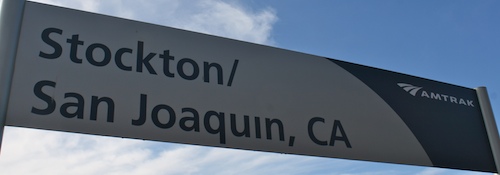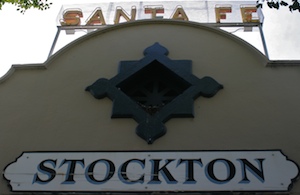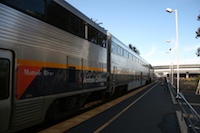


The Stockton/San Joaquin Station, located about six blocks south of downtown beyond the freeway of CA-4, has been used by Amtrak ever since the state supported San Joaquin begin in March 1974 with one daily round-trip and today sees service from the four daily trains to and from Oakland, the two round-trips to Sacramento stop at the Downtown/ACE station, 1.2 miles away. It is an important thruway connection point with service bus service meeting all trains north to Sacramento and down the Altamont Pass to San Jose (via a BART connection at Dublin/Pleasanton) and some as far north as Redding.
The station fully staffed with checked baggage service meeting all trains is in the historic 1900 mission style ATSF station building. Inside is a quite large (that can get crowded with two trains are scheduled to pass at similar times) waiting room with relatively modern black chairs with arms, for food there are just a few vending machines and outlets are hard to come by. There is a ticket window that can routinely have two agents working the line of passengers traveling to the San Francisco Bay Area or points south in the San Joaquin Valley. This depot is located at the eastern end of the modern full-length low-level platform with its tactile warning strip just beyond the grade crossing with San Joaquin Street where the platform begins. There is a second smaller, even lower simple black tar area at track level that can allow a train to stop along the second track in the station. The main medium-height platform dips down to track level at each of its ends and once in the middle to allow level crossings to this additional small platform, which is not used, in regular service. The platform when slightly raised has a simple low fence. The outside of the depot has some historical looking Stockton signs and even an old neon Santa Fe sign on along San Joaquin Street, there is minimal parking on the streetside of the depot with just 24 parking spaces. There is also a single pointless arrow era Stockton sign facing the platform. Continuing down the platform towards its western end is the stations four bus bays. These stop beneath a canvas shelter that looks like a sail and have an even more unique feature with their own non-public access road so the buses leave the station to Scotts Avenue and the west. A fence separates this bus loop from the public parking lot. The western end of the platform goes back down to track level where the wheelchair lift enclosure can be found and there is a small paved area to allow the baggage carts to pull a u-turn, another concrete path leads to the bus access road but bollards prevent driving onto the platform. Recently a few modern Stockton/San Joaquin, CA metal signs have been erected along the platform, one is an information panel.
2013: More work has been done on the platform, there are new lampposts, a new black fence, more signs that simply say Stockton, CA and the platform seems to be higher now. The little former black platform between the two tracks now seems more official with tactile warning strips along it and it's at a higher level
Photos 1-13 taken on 14 February, 2012, 14-55 on 21 February, 2012, 56-64 on 14 June, 2013, 65-90: 18 January, 2014
